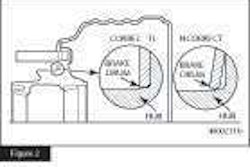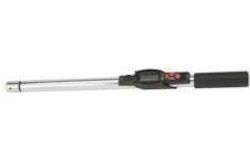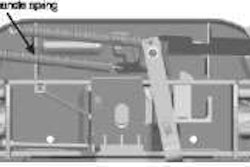Greater Grease
Every vehicle chassis presents several distinct lubrication needs. Is your grease up to the job?
There is plenty of metal hanging off a typical chassis, and it’s all under attack. With every twist and turn, contaminant or corrosive de-icing compounds are conspiring against vital vehicle parts.
But while one of the most effective weapons in the battle against these threats comes in the form of fresh layers of grease, many fleets are pushing lubricants to their limits.
“With extended (engine) oil drains, customers sometimes forget that the other components such as differentials, kingpins, fifth wheels, wheel bearings and coolant systems will get pushed out to these extended-drain intervals,” notes Len Badal, Chevron Lubricants’ commercial sector manager.
Shops need to be careful when trying to choose the right grease for each job.
The longer service intervals can present a number of challenges. Any grease will soften or oxidize if left in place too long. As viscosity changes, grease can be pushed out or washed away; any forming varnishes and deposits will contribute to unwanted wear.
It’s one of the reasons that some fleets are bringing equipment into shops for a “dry PM” that involves little more than grease applications, notes Stede Granger, Shell’s OEM technical manager. The engine oil may last as long as 50,000 miles, but the grease guns are being attached to zerk fittings at 25,000-mile intervals.
As important as that frequency is, shops still need to be careful when trying to choose the right grease for each job.
Three factors that separate one grease from the next include the choice of base oil, thickening agents and additives, explains Mark Betner, Citgo Petroleum’s manager for heavy-duty lubricants. Every difference will play a role in how well the lubricant will perform in a particular role.
Technicians applying grease to U-joints, for example, will likely prefer a formula that flows into the rollers with ease. In contrast, those trying to protect kingpins, tie rod ends and drag links would best be served by grease that has a heavier viscosity and resists water.
“There are several areas where different greases would not provide appropriate protection,” Badal explains. The grease used for a wheel bearing, for example, may be inappropriate for a fifth wheel, king pin or other locations on the chassis.
“Trailer wheel bearing greases are typically very soft (with an NLGI 0 or NLGI 00 grade) and would not have enough consistency or hardness to remain on the fifth wheel plates or chassis points and to resist the effects of mechanical stresses and exposure to the elements,” he says. Everything from the natural motion of a part to an ongoing spray of water can wash the softer lubricant away.
In contrast, a trailer wheel end filled with general chassis grease would face the threat of failure because of the high viscosity of the base oil, limited protection from cold weather or a lack of “slumpability” in the wheel bearing cavity, which would starve the bearings of lubricants, Badal adds.
Even though Chevron’s newly released Delo Grease ESI is designed for a long list of uses such as kingpins, fifth wheels, U-joints and truck wheel bearings, the company still recommends a different product for the unique requirements of trailer wheels because of the differences.
Of course, grease needs to reach its destination if it hopes to make any difference at all, and that leads to the importance of “pumpability.” Most U.S. truck shops tend to prefer No. 2 grease in the summer, since it will flow relatively easily and still hold in place, but northern fleets often switch to No. 1 grease when trying to ensure that grease reaches its destination in colder climes, Granger says.
The choice may have a lot to do with the conditions where technicians are working. No. 2 grease will pump into place with relative ease in a typical heated shop, Betner says. The biggest difference may be experienced during roadside repairs when technicians are trying to inject the protective formulas.
The layout of a shop can play a role in the importance of pumpability as well. Supplies might be housed in the corner of a 10-bay shop, or even in a separate building where heating coils need to help keep the fluid flowing. That will make it important to measure the pressure and flow available at the end of every line.
Shell, for example, offers a high-pressure gauge that can make sure static and no-flow pressures are sufficient, and then completes a flow check to make sure that a tool’s opening can dispense one pound of grease per minute.
That flow rate can mean the difference between a part being lubricated properly or being starved of grease altogether.
While inspecting one shop, Granger found a technician who was waiting a specific period of time while applying grease to spring pins, but was unaware that there wasn’t any lubricant passing through the fittings in the first place.
“If you have a pumping system that is very, very slow, the technician can get frustrated, and they’re probably not going to purge that joint,” he adds.
The ultimate pumpability can be influenced by the base oil used to make the grease. “The higher the base oil viscosity, the greater the degree of difficulty of dispensing at lower temperatures,” Granger says.
Of course, technicians also need to make sure they are applying enough grease through every opening or fitting. Granger, for example, was the member of a task force at Ryder that traced the premature failure of tie rod ends and drag link ends to a lack of lubricant.
The problem was solved by instructing teams to apply grease until a fresh supply began to appear out the other side.
As older chassis grease is being purged, technicians also have the opportunity to see how well the grease is surviving between existing service intervals.
“If it’s not burnt or milky in appearance, that means the grease has maintained its lubricating properties and has resisted the impact of contamination,” Betner says.
However, as threatening as a lack of grease may seem, there also can be too much of a good thing. Even though a lot of people believe “more is better,” exposed clumps of grease can attract debris, he adds. Once the lubricant inside an articulated component is pushed out or washed away, this debris can be sucked into the openings.
Any puddles of grease under a truck can be a cause of worry for a similar reason. If a U-joint has been running too hot, grease may reach its dropping point and flow out of the opening. As the U-joint cools down, it will create the internal vacuum that can attract moisture into the new cavity inside.
Still, temperature-related dropping points can be improved by choosing grease with a superior thickener. A “lithium complex” formula, for example, can handle temperatures that are higher than those that would cause a lithium grease to drop out, Betner says. Viscosities, meanwhile, can be manipulated with additions of polymers and additives.
But shops also need to be careful to ensure that different greases are compatible with those already in place.
This compatibility often is dictated by the lubricant’s thickener, which can come in the form of lithium or the corrosion-fighting offerings of “aluminum complex” and “calcium sulfonate” chemistry — the options that typically are used when identifying the type of grease.
“The thickeners can fight each other,” Betner explains. Suppliers offer charts that identify whether or not the formulas are compatible. One of the best ways to protect against compatibility issues is to completely purge any old grease wherever possible.
In many shops, however, this will present little cause for worry. Most fleets will be working with lithium or lithium-complex grease, but there are cases where a shop may end up with a formula using a polyurea thickener to deliver added durability, Granger adds. “If you do change thickener type, you need to check with each manufacturer.”
Those looking for an added layer of protection may even seek out the option of molybdenum disulfide grease (often known simply as “moly” grease), which leaves behind a protective coating after a mechanical motion pushes the rest of the lubricant away.
This might be valuable when working with something like highly loaded springs.
“The solids become trapped in all the nooks and crannies of the component, and it’s actually the solid lubricant,” Granger explains.
Reports of different test results also can be used to identify the formula that is best suited to solve a specific challenge.
The Four Ball Wear Test, for example, involves measuring the scars that are created through metal-on-metal wear.
“Generally speaking, this Wear Index Group tells you the load-carrying capability of the grease under heavy loads and maybe shock loads,” Betner says, referring to the way that the lab results translate into performance.
A five percent Salt Water Corrosion Test, meanwhile, will help to measure how well the grease can fight corrosion when exposed to ongoing spray from the road.
“If you’ve got a U-joint that has been contaminated with water and possibly calcium chloride, you would want a grease that would pass that test,” he adds.
The enhanced performance might come at a higher purchase price, but Betner tries to put it into perspective. A shop will add about 15 to 25 lbs. of grease to a Class 8 truck in a year, so the choice between one option and the next may equate to $30 annually. That will pale in comparison to the $80,000 spent on fuel.
In contrast, the better grease might last twice as long, allowing service intervals to be extended, or even offer the added protection that can extend the life of a component by thousands of extra miles.











